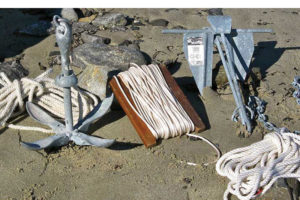Courtesy of our friends at Boat US. Check out USCG and local regulations and recommendations as well. In our waters I’d suggest bringing along extra clothing, foul weather gear and some kind of blanket. It can get cold out there, especially if you go overboard and then need to warm up. –KH
 ALEXANDRIA, Va., January 13, 2014 — There’s a lot to be said for owning small runabouts, center consoles or bow riders. While they are affordable, easy to store, and can keep everyone in the family happy, they have their limits, though, if you want to venture into coastal waters and big lakes. But these journeys can still be done, with the right ten pieces of equipment. Here’s what Boat Owners Association of The United States (BoatUS) recommends should be aboard every boat 20 feet or smaller:
ALEXANDRIA, Va., January 13, 2014 — There’s a lot to be said for owning small runabouts, center consoles or bow riders. While they are affordable, easy to store, and can keep everyone in the family happy, they have their limits, though, if you want to venture into coastal waters and big lakes. But these journeys can still be done, with the right ten pieces of equipment. Here’s what Boat Owners Association of The United States (BoatUS) recommends should be aboard every boat 20 feet or smaller:
Paddles: If your engine quits, paddles are your propulsion. Keep the outboard or sterndrive down for a rudder, and if you’ve got a buddy or a spouse aboard, you can make decent headway. A T-handle paddle, the kind used for whitewater canoeing, gives you a great grip. The aluminum shaft is light and strong, as is the high-impact plastic blade. Those materials don’t mind sitting out in the weather, either. Make sure they’re at least five feet long.
Dry box: Small boats typically lack dry storage. Large, plastic marine dry boxes with lids with O-rings seal out moisture and an extra-deep model can hold the radio, smartphone, flashlight, GPS and more, leaving them dry when you need them.
Anchors and line: Some small-boat manufacturers barely leave space for a lunch hook. But what happens if your engine quits, or you want to anchor overnight in a quiet cove? Stowing two anchors with different line lengths gives you options. Chain between line and anchor also helps. And don’t forget a few docklines.
Wearable life jacket: Luckily, life jacket design has evolved and you can find Type III vest-style models that are comfortable to wear all day. Plenty of small-boat owners wear inflatable jackets. They’re more buoyant, but more costly and require some care. Your best choice is any life jacket you’ll always wear.
Compatible power source for electronics: When your cell phone runs out of juice during a nautical emergency, that’s a crisis. Same goes for your flashlight, handheld GPS unit and VHF radio. Get devices that run on the same power source such as AA batteries and stow and extra sealed pack of batteries in the dry box.
Manual bailer: Small, closed-deck boats rely on a single, submersible pump to keep the bilge dry. But if that pump fails, or seawater comes over the gunwales or stern, or there’s heavy rain, you’ve got a problem. Keeping a hand-operated bilge pump aboard is cheap insurance.
Air Horn: The US Coast Guard says small boats must have a “sound-producing device” for distress signaling, capable of a four-second blast that’s audible one quarter-mile away. While a plastic whistle or an installed electric horn may meet the letter of the law, a better choice is a handheld, gas-powered air horn, which can be heard at much greater distances.
Spare prop and fix-It tools: A submerged ledge or log can whop your prop and cripple your boat. Having a spare prop and the right wrench is common advice, but changing a mangled wheel while afloat is easier said than done. Dents in aluminum props can be put back into serviceable shape, at least enough to get home. Beefy, vice-grip-style locking pliers and slip-joint pliers are essential for this repair.
Have a charging source: Cell phones don’t run on AA batteries. That’s why you need a marine rated 12-volt receptacle with a weatherproof cap. Mount it away from spray and rain, and don’t forget the charging cords for other electronics.
Paper chart in plastic cover: Even a waterproof chart is hard to manage underway in an open boat. But by putting it in a clear, plastic holder, wind and water won’t matter it will always be ready when you need it. You can buy one or make one with clear plastic from the hardware store and duct tape.